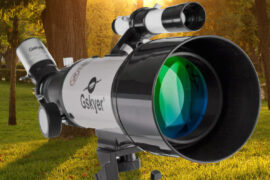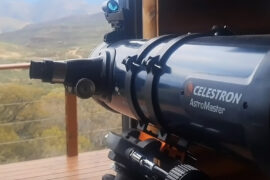Collecting telescope eyepieces to get the perfect view of every type of object in space can get expensive fast. As amateur astronomers, we are always looking for new ways to improve the images we get while saving money, so here’s a type of eyepieces that can do exactly that.
This is where accessories zoom eyepieces can be really handy. They can be an excellent addition to every stargazer´s toolbox and under the right circumstances, they can replace the need to have too many fixed (regular) eyepieces laying around.
This guide will help you to better understand zoom eyepieces and compare the most popular ones so you can pick the one that is just right for you.
What is a Zoom Eyepiece
A zoom eyepiece is a versatile type of telescope eyepiece with a variable focal length. Zoom eyepieces give you access to a wide range of magnification options in one single device.
Zoom eyepieces are designed with a dial or turning mechanism that allow you to adjust the focal length while the eyepiece is still inserted in the telescope’s focuser or star diagonal, eliminating the need to switch between eyepieces whenever you want to adjust the magnification.
Instead of buying multiple eyepieces to cover a wide range of focal lengths, you can simply get a zoom eyepiece and get access to all the magnification levels in-between.
Zoom eyepieces generally cover the mid-range of focal lengths. The most common sizes are 7-21mm and 8-24mm.
Advantages of Zoom eyepieces
- Multiple magnification levels in a single eyepiece
Zoom eyepieces can cover the magnification of many different eyepieces in a single package. This makes them extremely versatile and also saves a ton of storage space.
- Cheaper in comparison to buying multiple eyepieces
Zoom eyepieces are more expensive than getting one single fixed eyepiece of equivalent quality. However, you’d need 4 or more eyepieces to cover the same focal length range that a single zoom eyepiece has. So, when you compare the cost of those multiple eyepieces against the price of one zoom, the zoom comes out on top.
- No need to constantly change eyepieces
When you are starting out, it’s hard to get a feel for what magnification is the best fro the object you are trying to view, so you need to experiment a lot. Doing that with multiple eyepieces can be obnoxious as you need to switch them in and out every time. With zoom eyepieces you simply turn the focal length dial when you want to change it and you are done.
- Beginner-friendly
Using a zoom eyepiece is really easy and intuitive. Any beginner should be able to understand how they work simply by testing them for a few seconds.
Are zoom eyepieces worth it?
The best use case for zoom eyepiece is when you are looking to maximize the range of magnification options you have access to, but you don’t want to spend a lot of money in many eyepieces.
Zoom eyepieces are an excellent purchase if you recently bought your first telescope or if you are doing the research to get one soon. When you combine it with the fixed eyepieces that will most likely come bundled with the telescope, you will have enough focal length options to learn and figure out how to get the best image out of your optical setup.
Storage space is another valid reason to get a zoom eyepiece. It is way more practical to store and carry a single eyepiece than having a case full of them, especially if you plan to take your telescope on camping trips.
When not to buy a zoom eyepiece
While zoom eyepieces are versatile, they are not the perfect solution for every case either. There are some situations where getting regular fixed eyepieces can be a better option.
- Zoom eyepieces do not cover the extremes in the focal length ranges. If you need an eyepiece below 7mm or above 24mm, a fixed eyepiece is the better option.
- If you need an exact focal length size for a specific purpose, a fixed eyepiece will almost always have better optics as they have been manufactured, optimized, and tested for that single size.
- When the highest useful magnification of your telescope is somewhere in the middle of the zoom eyepiece range. It’s always important to know the maximum magnification your telescope can use and what eyepiece size you need to get there (here’s a handy chart if you don’t know yours). If your telescope can only make use of half the range in a zoom eyepiece, then it might not be worth buying one. This will be a rare case, as most telescopes can use at least the 7mm-24mm range.
How to choose a Zoom Eyepiece
There are a few specifications that you will want to consider when you are shopping for a zoom eyepiece. Here are the most important things to consider:
Barrel size
Zoom eyepieces come in the standard sizes of 1.25″ and 2″ so they can fit in any telescope with a slot that size. You simply need to make sure it matches. If you don’t know the barrel size for your telescope, there’s a 99% chance you need a 1.25″ barrel, but you can still double-check just to be sure. It should be listed in your telescope’s specifications or it might be printed on the side of one of your current eyepieces.
Multicoating
This is the first feature you want to look out for when purchasing any eyepiece, including zooms, and in general, any optical device that uses a lens. Multicoating means the lenses and mirrors inside have been treated several times to reduce light reflection.
Range
The range of the zoom eyepiece defines the minimum and maximum focal length it can reach. The two standard ranges are 7-21mm and 8-24mm. Both cover similar focal lengths, so it’s hard to go wrong with one or the other, but I personally like to use the 8-24mm and then use fixed eyepieces for the high power magnification below 8mm.
Zoom eyepiece vs Barlow lens
One common question about zoom eyepieces is how they compare against a Barlow lens and which one is better. The answer is really none, as they are not really equivalent devices.
Both Barlow lenses and zoom eyepieces allow you to increase your magnification levels, and give access to a wider range of options, but there’s no reason to put them against each other
In fact, you can use a zoom eyepiece with a Barlow lens. So there’s no reason why you can’t experiment with both, especially when Barlows are relatively cheap.
If you really, really have to decide between one or the other, we’d base the decision on how many eyepieces you currently have. If you have a few, then a Barlow will be very cost-effective, but if you only have a couple of eyepieces, then a zoom eyepiece will give you access to more focal lengths to play with.
Best Zoom Eyepieces
Let’s get to our selection for the best zoom eyepieces currently on the market. We have selected a variety of options for every price range so you can definitely find one that can be a good fit for you and your telescope.
Best value: Celestron Zoom Eyepiece 8-24mm

| Manufacturer | Celestron |
| Range | 8-24mm |
| Focus Type | Manual |
| Multi-coated | Yes |
| Angular field of view | 40°-60° |
| Eye relief | 5 mm-18 mm |
| Price |
An optical chain (Telescope lens > focuser > eyepiece > eye) is only as good as its weakest link. Because of this, it is important that you do not go too “low budget” when it comes to eyepieces. Keep in mind that an eyepiece can last you 10 years or even longer if you take good care of them, and can be used with future telescopes so it’s important that you get good value for your money so you don’t feel like you need to replace it soon due to low-quality optics.
This is why we have chosen a very reputable brand such as Celestron for our budget pick.
We have reviewed many Celestron products in the past and they are always very trustable and of high quality.
You can tell a lot about the quality of an eyepiece from the details like the outer build. In this case, the Celestron zoom eyepiece has a rubber grip that as any experienced astronomer will tell you, is always welcome as eyepieces tend to be dropped more than we’d like, especially during the winter when you can be wearing gloves to handle them.
The optics are what you’d expect from Celestron. Bright, crisp, good-quality images without any noticeable issues in terms of optical aberrations or reflections.
All in all, the Celestron 93230 will be a good start to a telescope accessory collection.
Best pick: Orion 8-24mm Pro Lanthanum Zoom Eyepiece
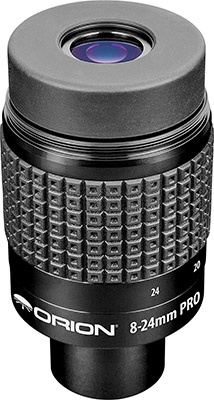
| Manufacturer | Orion |
| Range | 8-24mm |
| Focus Type | Manual |
| Multi-coated | Yes |
| Angular field of view | 40°-60° |
| Design | Parfocal |
| Waterproof | Yes |
| Price |
One of the things one has to get used to when using a zoom eyepiece is re-focusing every time you want to adjust the magnification.
The newest version of the Pro Lanthanum zoom eyepiece, which has existed for many years in multiple iterations, promises to fix this with what they call a “parfocal” design. But does it live up to the hype?
Well, I had the opportunity to test one a while ago and let me tell you, it works about 80% of the time, which is great and spoils you a little bit for when you do have to go and use a different zoom eyepiece.
Besides the parfocal design, the other main feature this zoom eyepiece has is its lanthanum lenses that reduce that minimize chromatic aberrations. In this regard is where it really shines, I believe. It produces some of the crisper, brighter images out of any zoom eyepiece on the market.
The only issue I could find with the Orion Pro Lanthanum is that it has a little bit of a smaller field view than what you might be used to in fixed eyepieces, but it seems like it’s a trade-off it had to make due to its design.
The outer build is very high quality with a rubberized grip. Orion also promises it is waterproof so you are good to go if you want to take it out camping.
All in all, it’s an excellent zoom eyepiece that covers the 8-24mm perfectly well. Even if you have a high-powered telescope, just pair this with a Barlow, and you might not even need another eyepiece in your box.
Best high-end: Baader Planetarium 8-24mm Hyperion
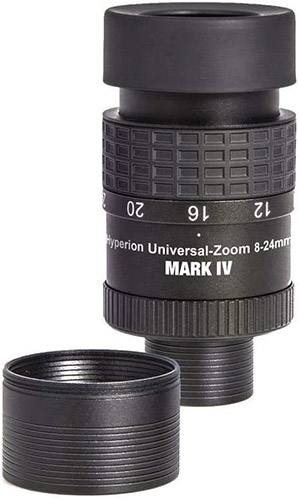
| Manufacturer | Baader Planetarium |
| Range | 8-24mm |
| Focus Type | Manual with clickstops |
| Multi-coated | Yes |
| Angular field of view | 50°-68° |
| Design | Parfocal |
| Price |
If you are looking for the best of the best, this is the one for you.
Made by Baader, one of the most high-quality brands in optics, the Hyperion is the premium zoom eyepiece.
There are a few features that get it to this point.
First, it has multiple click stops. Click stops are a feature in zoom eyepieces and other devices with variable lenses that put limits in between the zoom ranges to make it easier to figure out where you are without taking your eyes away from the lens. It’s a great quality-of-life type of feature that even though it’s not necessary, it’s really nice to have. The Hyperion Mark IV has click stops at 8, 12, 16, 20, and 24mm.
Just like the Orion Pro Lanthanum, the Hyperion also comes with a parfocal design that keeps the focus even while you are changing magnifications.
Another of the premium features of the Hyperion Mark IV is its high field of view. As it’s been mentioned in the reviews for the other zooms, one of the most difficult things to do in the manufacturing process of these devices is keeping the same field of view as fixed eyepieces. Most zooms have a field of view between 40 and 60 degrees. The Baader Hyperion comes with a 50 to 68 degrees field view.
Finally, on the inside, it has 7 different elements. That’s crazy!. Even the most complex, high-quality eyepieces are designed with 3 or 4 elements.
In case that wasn’t enough, it also comes with a 2″ adapter included in case you want to use it with a 2″ telescope.
The only “but” this zoom eyepiece might have is that it has a relatively low eye relief at only 12mm-15mm, but this shouldn’t be a problem for most users.
Best for planetary viewing: Tele Vue 3-6mm Nagler Zoom
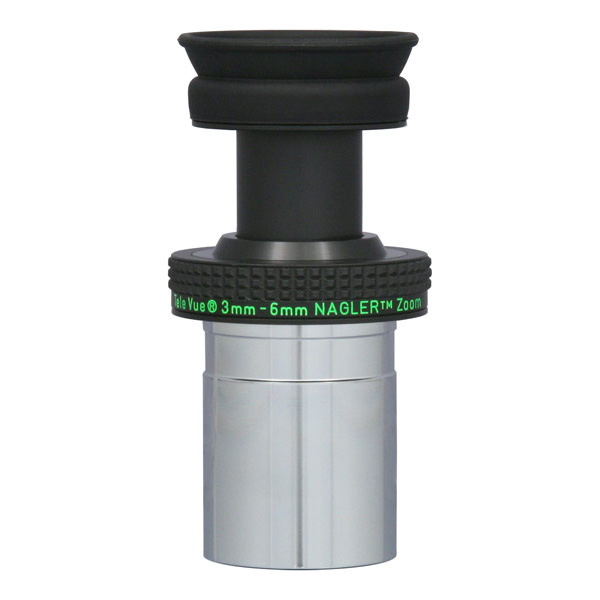
| Manufacturer | Tele Vue |
| Range | 3-6mm |
| Focus Type | Manual |
| Multi-coated | Yes |
| Angular field of view | 50° |
| Design | Parfocal |
| Price |
Not all zoom eyepieces are in the mid-range. Some more specialized devices can be found in the high magnification range.
High magnification/Low focal length eyepieces are used for lunar and planetary viewing because those are the type of objects that are close enough to be able to appreciate details with high-powered EPs. It’s always useful to have a few high-powered eyepieces in your collection that get close to your telescope’s max useful magnification. This is the range this Tele Vue zoom eyepiece covers.
Tele Vue is one of the most high-quality manufacturers in the world when it comes to optical devices. Their telescope accessories are highly regarded by astronomers as some of the best.
At the same time, their products are also found in the high end of the price range, but they are usually worth it when they are paired with equally high-quality telescopes. Using this with an entry-level 90mm telescope will not do much for the image as the telescope would become a bottleneck.
This zoom eyepiece incorporates elements from their Nagler eyepieces, which are generally regarded as the best in the business. It has all the features you would expect from a high-quality EP: parfocal, multicoating, etc.
The only minor caveat with this eyepiece is that because it has very little eye relief, it can be uncomfortable for people who wear glasses.
But other than that, this little device is a beast and definitely the best high-magnification zoom eyepiece that money can buy.





